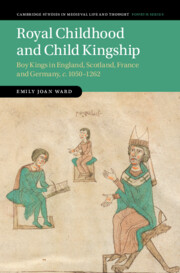Book contents
- Royal Childhood and Child Kingship
- Cambridge Studies in Medieval Life and Thought
- Royal Childhood and Child Kingship
- Copyright page
- Dedication
- Contents
- Figures
- Preface and Acknowledgements
- Abbreviations
- Genealogies
- Chapter 1 Royal Childhood and Child Kingship
- Part I Royal Childhood and Child Kingship: Models and History
- Part II Royal Childhood: Preparation for the Throne
- Part III Child Kingship: Guardianship and Royal Rule
- Chapter 7 Guardianship, Regency and Legality
- Chapter 8 Adapting and Collaborating
- Chapter 9 Feasting Princes?
- Chapter 10 Entering Adolescence
- Conclusion
- Bibliography
- Index
Chapter 9 - Feasting Princes?
Violence, Conflict and Child Kingship
from Part III - Child Kingship: Guardianship and Royal Rule
Published online by Cambridge University Press: 04 August 2022
- Royal Childhood and Child Kingship
- Cambridge Studies in Medieval Life and Thought
- Royal Childhood and Child Kingship
- Copyright page
- Dedication
- Contents
- Figures
- Preface and Acknowledgements
- Abbreviations
- Genealogies
- Chapter 1 Royal Childhood and Child Kingship
- Part I Royal Childhood and Child Kingship: Models and History
- Part II Royal Childhood: Preparation for the Throne
- Part III Child Kingship: Guardianship and Royal Rule
- Chapter 7 Guardianship, Regency and Legality
- Chapter 8 Adapting and Collaborating
- Chapter 9 Feasting Princes?
- Chapter 10 Entering Adolescence
- Conclusion
- Bibliography
- Index
Summary
Contextualising conflict provides further testimony of children’s legitimacy as rulers between the eleventh and thirteenth centuries. This chapter turns to narrative accounts of dynastic challenge, opportunistic conflict and kidnap to address the problematic association between child kingship and magnate violence. Evidence for the appearance and escalation of conflict while a boy was king has often been accepted without sufficient critical scrutiny. The chapter shows that attempts to remove children from their royal positions were rare, and that conflict often upheld their legitimacy to rule rather than undermining it. Applying the arbitrary label of violent opportunism to all instances of conflict when a child was king oversimplifies the complex range of reasons for magnate disputes. Instead, conflict could be, among other things, a legitimate response to royal succession, a habitual aspect of the negotiation of disputed property and rights, or a product of recurring quarrels over hierarchy and prominence. The child king’s presence and active participation could, once again, convey a significant and authoritative weight.
- Type
- Chapter
- Information
- Royal Childhood and Child KingshipBoy Kings in England, Scotland, France and Germany, c. 1050–1262, pp. 230 - 248Publisher: Cambridge University PressPrint publication year: 2022

